
Margam Castle, Margam, Port Talbot, Wales, is a late Georgian country house built for Christopher Rice Mansel Talbot. Designed by Thomas Hopper, the castle was constructed in a Tudor Revival style over a five-year period, from 1830 to 1835. The site had been occupied for some 4,000 years. A Grade I listed building, the castle is now in the care of Neath Port Talbot County Borough Council. The castle stands within Margam Country Park, the former estate to the house. The park is listed at Grade I on the Cadw/ICOMOS Register of Parks and Gardens of Special Historic Interest in Wales.
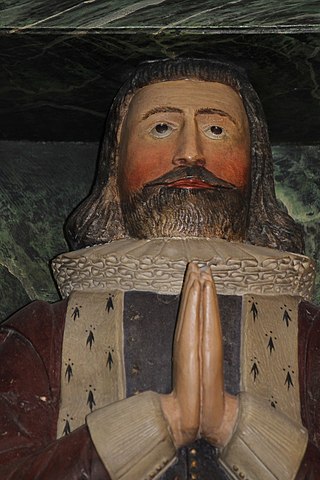
Sir John Trevor I (1563–1630) was a Welsh politician.

(New) Hawarden Castle is a house in Hawarden, Flintshire, Wales. It was the estate of the former British prime minister William Gladstone, having previously belonged to the family of his wife, Catherine Glynne. Built in the mid-18th century, it was later enlarged and externally remodelled in the Gothic taste.

Trevalyn Hall in Rossett, a Grade II* listed building, is an Elizabethan manor house near Wrexham in Wales. It was built by John Trevor in 1576. The Trevor family of Trevalyn were one of the leading families in East Denbighshire by about 1600 with numerous estates in both Flintshire and Denbighshire. The Plas Teg estate in Hope, Flintshire was also acquired by the Denbighshire branch of the family when it was purchased from a cousin by Sir John Trevor I (1563–1630) and it was he who built the present Plas Teg house in 1610.
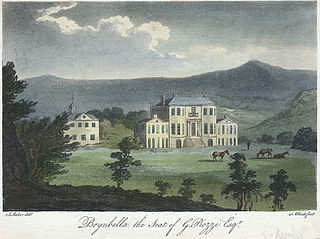
Brynbella is a neoclassical villa built near the village of Tremeirchion in Denbighshire, northeast Wales, by Hester Piozzi and her husband, Gabriel Piozzi. It was the seat of the Salusbury family from 1794 until 1920. The name is part Welsh and part Italian, meaning "Beautiful Hill".
This is a list of High Sheriffs of Flintshire.

Glynllifon is an old estate which belonged to the Barons Newborough, near the village of Llandwrog on the main A499 road between Pwllheli and Caernarfon in Gwynedd, Wales. The original mansion was until recently a privately owned hotel.
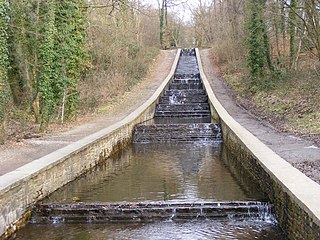
The Gnoll Country Park is a park in Wales. It is an early-18th-century landscaped garden covering over 100 acres (0.40 km2) in the Vale of Neath, in Neath Port Talbot county borough in south Wales. The park is designated Grade II* on the Cadw/ICOMOS Register of Parks and Gardens of Special Historic Interest in Wales.
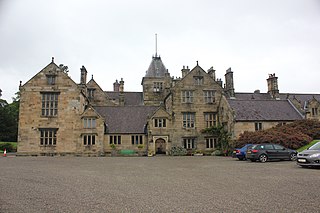
Mostyn Hall is a large house standing in 25 acres of garden near the village of Mostyn, Flintshire, Wales. It is designated by Cadw as a Grade I listed building.
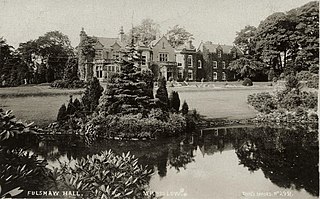
Fulshaw Hall is a country house, south of the civil parish of Wilmslow, in Cheshire, England. It is recorded in the National Heritage List for England as a designated Grade II listed building.

Fulshaw Hall is a country house, south of the civil parish of Wilmslow, in Cheshire, England. It is recorded in the National Heritage List for England as a designated Grade II listed building.
The Baronetcy of Ellis-Nanney of Gwynfryn and Cefndeuddwr was granted to Hugh Ellis-Nanney in 1898. The 1st baronet was a landowner with a 12,000-acre (4,900 ha) estate in North Wales, UK, most of which was inherited from his father, Owen Jones Ellis-Nanney. The family were political Conservative party members within the parliamentary constituency of Caernarfon, Wales.

Soughton Hall is a Grade II* listed country house hotel in Sychdyn, Flintshire, Wales. Notable guests that have stayed include Luciano Pavarotti, Michael Jackson and King Juan Carlos I of Spain. William John Bankes inherited Soughton Hall in the 1815.

Gyrn Castle is a Grade II-listed castellated mansion in Llanasa in Flintshire.

Wrexham Archives and Local Studies holds the archives for the city of Wrexham. The archives are held at County Buildings, on Regent Street, Wrexham, and run by Wrexham County Borough Council as part of its Wrexham Archives and Local Studies Service. The centre was initially named after local Wrexham historian Alfred Neobard Palmer. The building is shared with Wrexham County Borough Museum and the archives opened in 2002.

Nannau is a Georgian mansion and estate near the village of Llanfachreth, Gwynedd, North Wales, UK. The mansion was initially inhabited by the Welsh Nanney (Nannau) family, who were direct descendants of the Kings of Powys. For over 900 years, the Nannau estate was in possession of the same family.

Nerquis Hall is a 17th-century gentry house located in the North Wales village of Nercwys, Flintshire. Completed in the mid-1600s, the hall has survived in good condition and is currently a private residence. Nerquis Hall was designated a Grade I listed building in October 1952.

Flintshire is a county in the north-east of Wales. It covers an area of 437.5 km2 (168.9 sq mi) and in 2021 the population was approximately 155,100.

Golden Grove is an Elizabethan house to the west of the village of Llanasa, Flintshire, Wales. The mansion dates from 1578 and was built by Sir Edward Morgan, an official at the court of Elizabeth I. In the 19th century the estate was bought by Henry Pochin, owner of Bodnant Hall in neighboring Conwy, whose daughter, Laura, laid out the grounds at Golden Grove. The house is designated by Cadw as a Grade I listed building and the gardens and grounds are designated Grade II on the Cadw/ICOMOS Register of Parks and Gardens of Special Historic Interest in Wales.

Henblas is an Renaissance house in the village of Llanasa, Flintshire, Wales. The mansion dates from 1645 and was built by the Morgan family of Golden Grove, a country estate to the west of Llanasa, as a home for two unmarried sisters. The house is designated by Cadw as a Grade I listed building.


















